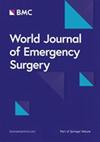过去 18 年日本在创伤抢救中使用血管内球囊主动脉闭塞术(REBOA)的情况及其效果:一项全国性描述性研究
IF 5.8
1区 医学
Q1 EMERGENCY MEDICINE
引用次数: 0
摘要
主动脉血管内球囊闭塞复苏术(REBOA)已被用于控制大出血。尽管对 REBOA 的疗效尚未达成共识,但在没有创伤外科医生的非创伤中心,REBOA 仍不失为一种桥接疗法。为了更好地了解REBOA的应用现状,我们研究了其在日本的使用情况、目标人群和治疗效果的变化,因为在日本有时无法进行即时止血手术。这项回顾性观察研究使用了日本创伤数据库的数据。研究纳入了 2004 年 1 月至 2021 年 12 月期间实施 REBOA 的所有病例。主要结果是院内死亡率。我们根据病例数、中心数、损伤严重程度以及与使用REBOA相关的总死亡率和亚组死亡率,分析了死亡率随时间变化的趋势。我们对死亡率随时间变化的趋势进行了逻辑分析,并根据创伤和损伤严重程度评分调整了存活概率。共有2557名患者接受了REBOA治疗,并被认为符合纳入条件。参与者的中位年龄为55岁,男性患者占研究总人数的65.3%。钝性创伤约占病例总数的 93.0%。直到2019年,使用REBOA的病例和设施数量都在增加。虽然在整个观察期内,受伤严重程度评分和修订创伤评分没有变化,但住院死亡率却从91.3%降至50.9%。与使用 REBOA 的所有患者组和所有创伤患者组相比,没有严重头部或脊柱损伤的 REBOA 组死亡率改善幅度更大。收缩压≥80 mmHg的患者死亡率改善幅度最大。调整后的住院死亡率几率比持续下降,即使在调整了存活概率后也是如此。虽然患者的严重程度没有明显变化,但接受 REBOA 治疗的患者死亡率却随着时间的推移而下降。要确定创伤护理得到改善的原因,还需要进一步的研究。本文章由计算机程序翻译,如有差异,请以英文原文为准。
Use of resuscitative endovascular balloon occlusion of the aorta (REBOA) for trauma and its performance in Japan over the past 18 years: a nationwide descriptive study
Resuscitative endovascular balloon occlusion of the aorta (REBOA) has been used to control massive hemorrhages. Although there is no consensus on the efficacy of REBOA, it remains an option as a bridging therapy in non-trauma centers where trauma surgeons are not available. To better understand the current landscape of REBOA application, we examined changes in its usage, target population, and treatment outcomes in Japan, where immediate hemostasis procedures sometimes cannot be performed. This retrospective observational study used the Japan Trauma Data Bank data. All cases in which REBOA was performed between January 2004 and December 2021 were included. The primary outcome was the in-hospital mortality rate. We analyzed mortality trends over time according to the number of cases, number of centers, severity of injury, and overall and subgroup mortality associated with REBOA usage. We performed a logistic analysis of mortality trends over time, adjusting for probability of survival based on the trauma and injury severity score. Overall, 2557 patients were treated with REBOA and were deemed eligible for inclusion. The median age of the participants was 55 years, and male patients constituted 65.3% of the study population. Blunt trauma accounted for approximately 93.0% of the cases. The number of cases and facilities that used REBOA increased until 2019. While the injury severity score and revised trauma score did not change throughout the observation period, the hospital mortality rate decreased from 91.3 to 50.9%. The REBOA group without severe head or spine injuries showed greater improvement in mortality than the all-patient group using REBOA and all-trauma patient group. The greatest improvement in mortality was observed in patients with systolic blood pressure ≥ 80 mmHg. The adjusted odds ratios for hospital mortality steadily declined, even after adjusting for the probability of survival. While there was no significant change in patient severity, mortality of patients treated with REBOA decreased over time. Further research is required to determine the reasons for these improvements in trauma care.
求助全文
通过发布文献求助,成功后即可免费获取论文全文。
去求助
来源期刊

World Journal of Emergency Surgery
EMERGENCY MEDICINE-SURGERY
CiteScore
14.50
自引率
5.00%
发文量
60
审稿时长
10 weeks
期刊介绍:
The World Journal of Emergency Surgery is an open access, peer-reviewed journal covering all facets of clinical and basic research in traumatic and non-traumatic emergency surgery and related fields. Topics include emergency surgery, acute care surgery, trauma surgery, intensive care, trauma management, and resuscitation, among others.
 求助内容:
求助内容: 应助结果提醒方式:
应助结果提醒方式:


